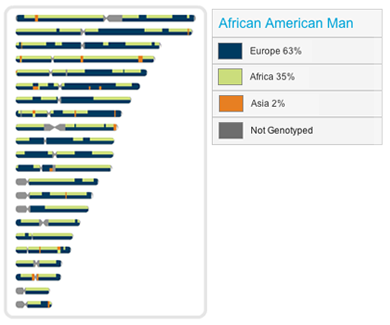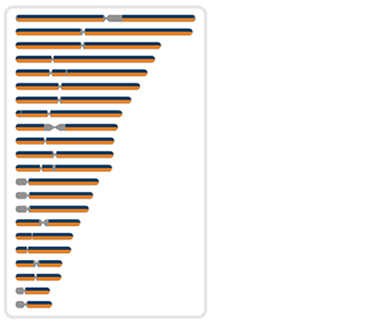As I mentioned in a previous post, I recently had my DNA tested by 23andme.com. One feature of their DNA testing is finding out one's DNA haplogroups. There are two types of genetic haplogroups: Mtdna and Y-Dna. Mtdna is found on the X chromosome. Everyone--male and female- inherits the dominant X chromosome from their mother. She, in turn, inherited her mtdna from her mother, and her mother inherited hers from HER mother--and so on and so on. Eventually this mtdna, and all the people who share it, could be traced to one woman!
Most people of European ancestry are one of seven haplogroups: H, V, J, T, K, U, and X. Certain mtdna haplogroups are more common in certain areas. For example, most people with Ashkenazi Jewish ancestry will have mtdna haplogroup K. Many people of Spanish ancestry will be a member of haplogroup H.
I am a member of Haplogroup T1a1, which is a subclade of haplogroup T. This means that my mother is a T1a1, and her mother, Helen Pancake (Woods) Dungan was a T1a1. Helen's mother, Clara Lengerich was also a T1a1, as was HER mother Francis Brokamp, as was HER mother Elizabeth Wattercutter, as was HER mother Maria Angela Rusche.
Maria Angela Rusche is as far back as I have been able to research my mtdna line. She was born somewhere in Germany in 1814. She married my 4th great-grandfather, Ferdinand Wattercutter on June 6, 1837 in Minster, Ohio. (Cue the Twilight Zone music...June 6 is also my wedding anniversary ). She died in Minster in 1837.
Mothers pass down their mtdna to ALL their children. This means that my son, Adam, is also a T1a1, and so are my siblings. My maternal uncles, my grandmother's siblings, and any children of my grandmother's sisters are also T1a1. Wow, that is a LOT of people!
Mtdna haplogroup T1a1 is most common in the United Kingdom. This struck me as odd until I read that is it believed that this haplogroup was spread into the UK by Vikings. Vikings?? How does that tie to Maria Angela Rusche? Helen didn't look like a Viking! Well, as far as I have been able to ascertain, most of my German relatives on BOTH sides on my family settled in the same area: Minster/ Shelby, Ohio. And they all came from the same area of Germany: Oldenburg, Lower Saxony. Oldenburg is very close to the North Sea...which is close to Scandinavia, hence the "Viking" connection. Additionally, most people of British ancestry are of Anglo-Saxon origin, so it all seems to fit.
All people of haplogroup T share a common female ancestor, many, many of thousands of years ago. Members of the British monarchy, such as George I, Charles I, and George III (who lost the USA) and George V ( the current Queen's grandfather) have been members of haplogroup T. The last czar of Russia, Nicholas II, was also a member of haplogroup T. It was through mtdna analysis that they were finally able to identify the czar's family's remains--- Prince Philip's DNA was used to identify the czarina and her children, as they were maternally related. American outlaw Jesse James also belonged to group T. Somewhere, somehow I am related to all of these persons.
Most people of European ancestry are one of seven haplogroups: H, V, J, T, K, U, and X. Certain mtdna haplogroups are more common in certain areas. For example, most people with Ashkenazi Jewish ancestry will have mtdna haplogroup K. Many people of Spanish ancestry will be a member of haplogroup H.
I am a member of Haplogroup T1a1, which is a subclade of haplogroup T. This means that my mother is a T1a1, and her mother, Helen Pancake (Woods) Dungan was a T1a1. Helen's mother, Clara Lengerich was also a T1a1, as was HER mother Francis Brokamp, as was HER mother Elizabeth Wattercutter, as was HER mother Maria Angela Rusche.
Maria Angela Rusche is as far back as I have been able to research my mtdna line. She was born somewhere in Germany in 1814. She married my 4th great-grandfather, Ferdinand Wattercutter on June 6, 1837 in Minster, Ohio. (Cue the Twilight Zone music...June 6 is also my wedding anniversary ). She died in Minster in 1837.
Mothers pass down their mtdna to ALL their children. This means that my son, Adam, is also a T1a1, and so are my siblings. My maternal uncles, my grandmother's siblings, and any children of my grandmother's sisters are also T1a1. Wow, that is a LOT of people!
Mtdna haplogroup T1a1 is most common in the United Kingdom. This struck me as odd until I read that is it believed that this haplogroup was spread into the UK by Vikings. Vikings?? How does that tie to Maria Angela Rusche? Helen didn't look like a Viking! Well, as far as I have been able to ascertain, most of my German relatives on BOTH sides on my family settled in the same area: Minster/ Shelby, Ohio. And they all came from the same area of Germany: Oldenburg, Lower Saxony. Oldenburg is very close to the North Sea...which is close to Scandinavia, hence the "Viking" connection. Additionally, most people of British ancestry are of Anglo-Saxon origin, so it all seems to fit.
All people of haplogroup T share a common female ancestor, many, many of thousands of years ago. Members of the British monarchy, such as George I, Charles I, and George III (who lost the USA) and George V ( the current Queen's grandfather) have been members of haplogroup T. The last czar of Russia, Nicholas II, was also a member of haplogroup T. It was through mtdna analysis that they were finally able to identify the czar's family's remains--- Prince Philip's DNA was used to identify the czarina and her children, as they were maternally related. American outlaw Jesse James also belonged to group T. Somewhere, somehow I am related to all of these persons.
The second haplogroup one can be assigned to at 23andme.com is Y-DNA. This type of DNA is passed from father to son. For example my nephew inherited his Y-DNA from my brother, who inherited his from my dad, who inherited his from my grandfather, Lester Sommer(s), who inherited his from HIS father Anthony Sommer. Anthony inherited this DNA from his father, John Joseph Sommer, who inherited from his father, John Fredrich Sommer, who inherited from his father, Stephan Sommer. Stephan Sommer was my 4th great grandfather and is as far back as I have traced my patrilineal line. He was born somewhere around 1770 in Oldenburg, Lower Saxony, Germany --also where I suspect my matrilineal line originated.
Which Y-DNA group do I belong to? I do not know! Remember to have this DNA, one must have a Y chromosome, and therefore to be male. Since I do not have a y-chromosome (thank God my life is not ruled by one of those things), I do not know which haplogroup I belong. Since my dad is deceased (and therefore cannot be tested), I would have to prevail upon one of my brothers, nephews, paternal uncle or my paternal uncles' sons to be tested to find out. I cannot find out from my son, as he has HIS father's y-DNA. Who someone volunteer??? Please!


